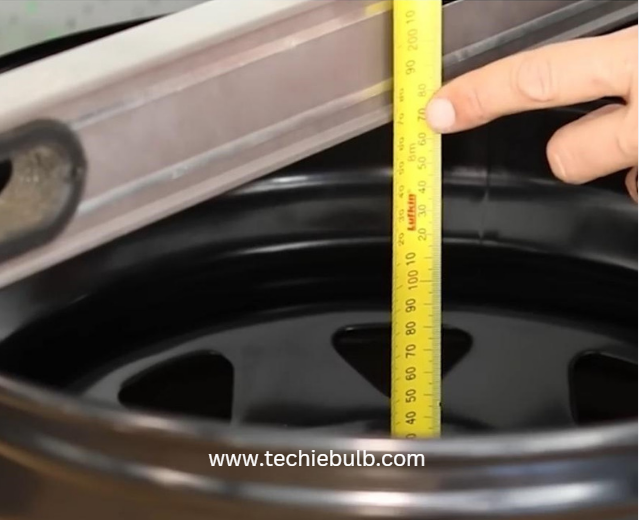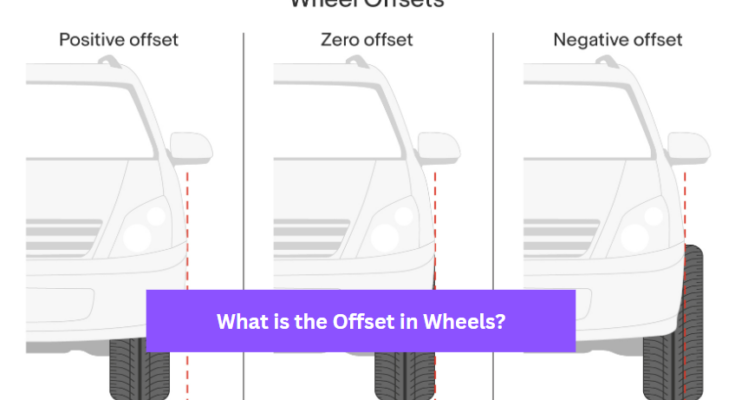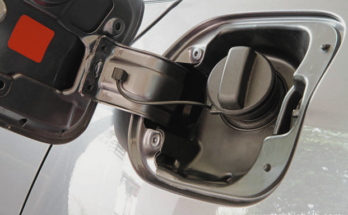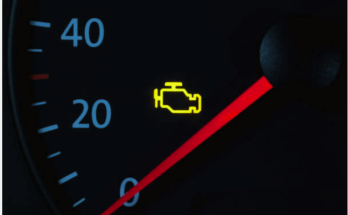Wheel offset is a critical parameter that significantly influences how your vehicle handles, looks, and performs.
Wheel offset isn’t just a technical specification; it’s a crucial factor in achieving the desired driving experience from steering response to tire clearance and even fuel efficiency, the right wheel offset can make your journey amazing. This blog will explore ‘What is the Offset in Wheels? with real-world examples, case studies, and expert insights to deepen your understanding of why wheel offset matters.
Wheel offset refers to the distance between the wheel’s mounting surface and its centerline. It plays a crucial role in determining how the wheels fit within the wheel wells of a vehicle. The offset is typically measured in millimeters and can be positive, negative, or zero.
A positive offset means the mounting surface is closer to the vehicle’s exterior, resulting in the wheel sitting more inward. This configuration is common in most factory wheels.
On the other hand, a negative offset means the mounting surface is closer to the wheel’s outer face, pushing the wheel further outward. This is often seen in aftermarket wheels and can contribute to a wider track and a more aggressive look.
Choosing the right offset is essential for proper wheel fitment, steering geometry, and overall vehicle performance. Incorrect offset may lead to rubbing against the fenders, and suspension components, or affect handling.
When considering new wheels, it’s crucial to adhere to the manufacturer’s recommendations or seek guidance from professionals to ensure compatibility with your specific vehicle.
What Wheel Offset I need?
Every vehicle has a minimum and maximum offset tolerance that it can employ, no vehicle has a predefined number that it must have. To avoid fitment problems, it is crucial that the wheels you select fall between the minimum and maximum offset ranges.
As an illustration, if you try to install a wheel with a without any idea of wheel offset, you run the risk of your tires rubbing on your fenders or the wheels and tires poking out. For example, your car may require a minimum offset of 35 and a maximum offset of 45. Additionally, you run the risk of the wheel interfering with your suspension parts if you try to install a 50-inch wheel.
Particularly elevated trucks, which can withstand a broader minimum and maximum range, give trucks a bit more flexibility. Let’s use trucks as an example, where your lowest offset tolerance is 0 and your maximum offset tolerance is 12.
Look for a wheel whose offset is less than your minimal tolerance of 0 if you want the wheels to protrude past your fenders. Go for solutions that are closest to your maximum tolerance of 12 if you want the wheels to protrude the least or not at all.
In short, to ascertain the required offset for your vehicle, consult the owner’s manual, check the driver’s side door jamb, or inspect the information sticker inside the fuel filler door. These sources typically provide details about recommended tire size and pressure, including the optimal wheel offset for your specific vehicle model. In cases of vehicle modifications or consideration of aftermarket wheels, it is advisable to seek guidance from a professional mechanic or tire specialist to ensure proper fitment and adherence to your vehicle’s specifications.
How Wheel Offset Affects Your Car
One of the primary effects of wheel offset is on the vehicle’s handling characteristics. The offset determines the track width or the lateral distance between the left and right wheels.
An appropriate offset contributes to stability during turns and enhances overall handling. A wider track, achieved with a positive offset, can provide better cornering stability, while a negative offset, bringing the wheels further outward, might contribute to a more responsive steering feel.
Additionally, wheel offset plays a pivotal role in the aesthetics of a car. The positioning of the wheels within the wheel wells affects the overall stance and appearance. Enthusiasts often seek a particular offset to achieve an aggressive or flush look, aligning the wheels precisely with the fender edges. This visual aspect is not only about style but can also impact the perceived performance of the vehicle.
Improper wheel offset can lead to practical issues as well. For instance, choosing an offset that deviates significantly from the manufacturer’s recommendations may result in rubbing against the fenders or suspension components. This interference can cause premature tire wear, compromise safety, and negatively affect the car’s handling dynamics.
Moreover, wheel offset influences the vehicle’s weight distribution, affecting factors like braking performance and tire wear. An ideal offset ensures that the load is evenly distributed across all wheels, promoting balanced handling and consistent tire wear.
Understanding the Varied Types of Wheel Fitment
Wheel fitment encompasses various configurations to achieve optimal positioning and compatibility with a vehicle. The primary types of wheel fitment include:
Deep Dish Fitment:
- Features a significant negative offset, pushing the wheel outward.
- Emphasizes a pronounced, recessed appearance for a distinctive look.
Flush Fitment:
- Aims to align the wheel’s outer edge with the fender for a sleek and even profile.
- Achieves a balanced appearance without excessive protrusion or tucking.
Poke Fitment:
- Exhibits a noticeable outward extension of the wheel beyond the fender.
- Common in certain customization styles, offering a bold and assertive stance.
Tucked Fitment:
- Involves positioning the wheels slightly inward, often flush with the fender.
- Prioritizes a clean and subtle aesthetic, reducing the visibility of the wheels.
Stance Fitment:
- Encompasses a variety of fitment styles focused on enhancing the vehicle’s overall stance.
- Can incorporate elements of positive, negative, or zero offset based on individual preferences.
How Wheel Offset Is Measured Step by Step

The measurement is calculated based on whether it’s positive, negative, or zero offsets, indicating the precise relationship between the mounting surface and the centerline of the wheel. Understanding and selecting the appropriate wheel offset is essential for achieving proper fitment, optimal handling, and the desired visual appearance of the vehicle. Measuring wheel offset involves a straightforward process. Follow these steps:
Step 1: Gather Essential Tools and Information
Before you begin measuring wheel offset, ensure you have the necessary tools:
- Tape measure or ruler
- Straight edge
- Pen and paper
Also, gather information about your wheels, including:
- Wheel width
- Diameter
- Bolt pattern
Step 2: Locate the Wheel’s Mounting Surface
Identify the mounting surface of the wheel. This is the area where the wheel contacts the hub. It’s crucial to measure from this point to determine the wheel’s offset accurately.
Step 3: Measure Wheel Width
Use a tape measure or ruler to measure the width of the wheel. Measure from the inner edge to the outer edge, ensuring accuracy. Note down this measurement for reference.
Step 4: Measure Diameter
Measure the diameter of the wheel from one end to the other, passing through the center. Record this measurement, as it contributes to the overall specifications needed for calculating the offset.
Step 5: Determine the Wheel’s Centerline
Locate the centerline of the wheel by measuring from the inner edge to the outer edge and dividing the result by 2. This provides the center point, crucial for calculating offset accurately.
Step 6: Measure Mounting Surface to Wheel’s Centerline
With the straight edge, measure the distance from the wheel’s mounting surface to the centerline. This measurement is your wheel offset. If the mounting surface is closer to the outer face of the wheel, it’s a positive offset. If it’s closer to the inner side, it’s a negative offset.
Step 7: Record the Offset Measurement
Record the offset measurement, specifying whether it is positive or negative. This information is vital when choosing new wheels or ensuring proper fitment when customizing your vehicle.
Step 8: Use Online Calculators for Verification
For added accuracy, you can use online wheel offset calculators to verify your measurements. Input the recorded values, and the calculator will confirm the accuracy of your measurements.
Step 9: Consider Other Factors
While measuring wheel offset is crucial, consider other factors like clearance with suspension components, fenders, and brake calipers. Ensure the chosen offset aligns with your vehicle’s specifications and won’t lead to rubbing or interference.
Step 10: Seek Professional Guidance
If you are unsure or want expert advice, consider consulting with professionals or experienced enthusiasts. They can provide valuable insights based on their expertise and help you make informed decisions.
How to find Wheel Offset?
Finding the wheel offset of a wheel is a straightforward process, and you can usually locate this information on the wheel itself or through the manufacturer’s specifications. Here’s how to find the wheel offset:
Method 1: Check the Wheel Stampings:
Inspect the Wheel:
Examine the inner rim of the wheel for stampings or markings.
Look for Offset Information:
Search for numbers or codes that indicate the wheel offset. Common notations include:
- “ET” (German abbreviation for “Einpresstiefe,” which means offset)
- Numerical values followed by “mm” (millimeters) or “in” (inches)
- Positive (+) or negative (-) signs indicating the offset direction
Identify the Offset Value:
The offset value is usually expressed in millimeters (mm) or inches. It may be a single numerical value (e.g., +35mm) or a range (e.g., ET40).
Method 2: Check Manufacturer Specifications:
Consult the Wheel Documentation:
Refer to any documentation or packaging that came with the wheels. This information may include details about the wheel offset.
Visit the Manufacturer’s Website:
Look up the manufacturer’s website and navigate to the specific product or wheel model. The offset is often listed in the technical specifications.
Method 3: Measure the Wheel:
Use a Measuring Tape:
Measure the distance from the wheel’s mounting surface (where it contacts the hub) to the wheel’s centerline.
Calculate the Offset:
For positive offset, if the mounting surface is closer to the outer face of the wheel, the offset is positive.
For negative offset, if the mounting surface is closer to the inner side of the wheel, the offset is negative.
Method 4: Consult a Professional:
Visit an Auto Shop or Dealership:
Take your vehicle or wheel to an auto shop or dealership.
Ask a professional technician to help you identify the wheel offset. They may use specialized tools or reference guides.
Important Tips:
Offset Direction: Positive offset brings the wheel closer to the vehicle. Negative offset pushes the wheel outward, away from the vehicle.
Check All Wheels: If you are unsure or if your vehicle has different-sized wheels on the front and rear axles, check the offset on all wheels.
Online Resources: Some wheel manufacturers provide online tools or calculators that allow you to input wheel specifications and retrieve offset information.
By using these methods, you should be able to find the wheel offset of your wheels and ensure that you have accurate information for fitment and customization purposes.
Conclusion
In conclusion, understanding and optimizing wheel offset is an integral aspect of enhancing your driving experience. By following the guidelines provided in this blog post, you can make informed decisions that not only improve performance but also elevate the visual appeal of your vehicle.
Remember, the journey towards the perfect wheel offset is unique for every car enthusiast. Embrace the knowledge shared here, apply it to your specific vehicle, and embark on a thrilling ride that combines performance and style.




